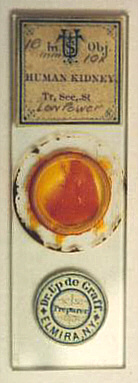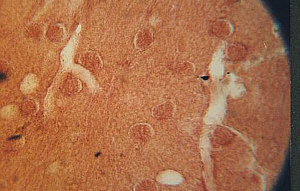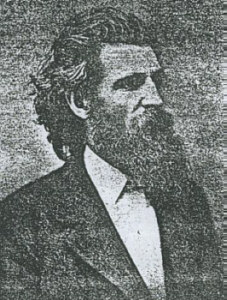Old Slides Have Interesting
Stories To Tell by Barry B. Miller, New Jersey, U.S. |
Sometimes, old microscope slides have two stories to tell. One, of course, relates to the subject matter that lies beneath the cover glass. There may, however, be another even more interesting story related to the person who prepared the slide. Uncovering that story requires a little investigating; but, that effort may be worthwhile. Dr. Brian Bracegirdle's excellent book, Microscopical Mounts and Mounters, is a valuable place to start in obtaining this information.
 I have a small collection of
nineteenth century microscope slides. Some of those slides do not identify the preparer;
however, others do specify the preparer's name and city. For those slides that have this
sort of information, I have found it to be worthwhile to investigate whether there is an
historical society or other organization for that area. Such organizations keep records of
notable people who lived there long ago. Often, there is no information for the person you
are investigating. Sometimes, the only available information is a short passage within a
reference book of persons who lived at the time you are interested in. Occasionally,
however, there is an entire file for a particularly notable person and much valuable
biographical information may be obtained.
I have a small collection of
nineteenth century microscope slides. Some of those slides do not identify the preparer;
however, others do specify the preparer's name and city. For those slides that have this
sort of information, I have found it to be worthwhile to investigate whether there is an
historical society or other organization for that area. Such organizations keep records of
notable people who lived there long ago. Often, there is no information for the person you
are investigating. Sometimes, the only available information is a short passage within a
reference book of persons who lived at the time you are interested in. Occasionally,
however, there is an entire file for a particularly notable person and much valuable
biographical information may be obtained.
One of my slides was prepared by Dr. Thaddeus S. Up de
Graff of Elmira, New York. A photograph of the slide - which is a section of human kidney
- is shown right. Notice the monogram on the label, which is composed of the superimposed
letters "T," "S," and "U." Also shown below is the slide as
it appears at 100 magnification. In 1993, I wrote to the historical society in Elmira, New
York and they sent me a wealth of biographical information related to Dr. Up de Graff. He
was a remarkable person. His life was tragically short but he left his mark, as he
contributed to the fields of microscopy and medicine, and he fought in the American Civil
War.

 Thaddeus Stevens Up de Graff
was born in Harrisburg, Pennsylvania in 1839. His father, John J. Up de Graff, was a
physician and he continued that tradition, as did his own son Thaddeus Up de Graff, Jr.
Thaddeus Up de Graff graduated from medical school in 1859 and took up the practice of
medicine in the city of Indianapolis. In response to the outbreak of the American Civil
War, Dr. Up de Graff set aside his medical practice and assembled and trained a company of
men. He drilled them and marched to the battle front as their captain. Those soldiers
became part of the Twenty-sixth Regiment of Illinois Volunteers and they took part in
several battles. Captain Up de Graff was wounded at the Battle of Mill Spring, Kentucky
causing him to become very ill and he was compelled to resign. After he recovered
sufficiently, he resumed the practice of medicine, with his office in Elmira, New York. He
specialized in treatment of the eye, ear, and throat. He performed more than 800
operations for removal of cataracts.
Thaddeus Stevens Up de Graff
was born in Harrisburg, Pennsylvania in 1839. His father, John J. Up de Graff, was a
physician and he continued that tradition, as did his own son Thaddeus Up de Graff, Jr.
Thaddeus Up de Graff graduated from medical school in 1859 and took up the practice of
medicine in the city of Indianapolis. In response to the outbreak of the American Civil
War, Dr. Up de Graff set aside his medical practice and assembled and trained a company of
men. He drilled them and marched to the battle front as their captain. Those soldiers
became part of the Twenty-sixth Regiment of Illinois Volunteers and they took part in
several battles. Captain Up de Graff was wounded at the Battle of Mill Spring, Kentucky
causing him to become very ill and he was compelled to resign. After he recovered
sufficiently, he resumed the practice of medicine, with his office in Elmira, New York. He
specialized in treatment of the eye, ear, and throat. He performed more than 800
operations for removal of cataracts.
Despite his busy schedule, Dr. Up de Graff became a noted microscopist. He was awarded the degree of Fellow of the Microscopical Society of Great Britain. He discovered a new species of infusoria that he named Brachionis gleasonii in honor of his friend Dr. Silas O. Gleason. Dr. Up de Graff and Dr. Gleason together founded a microscopical society in Elmira, New York.
For several years, Dr. Up de Graff enjoyed spending one or two months of his summers at Bodines in Pennsylvania, where he camped and fished for trout. He wrote a book, Bodines, or Camp Life on the Lycoming, which was very popular in its day. Sadly, after a long illness (Bright's Disease), Dr. Thaddeus Up de Graff died. During his illness he sometimes used to say, "If only I could go to Bodines again I am sure I could get well."
Among the biographical materials sent to me was the following anecdote. I have included it just as it was written.
"Thaddeus Up de Graff, Sr. was surgeon for the Pennsylvania Railway at one time and was in the habit of riding horseback when in a hurry to attend someone injured on the Railway. He was very fond of animals and one day saw a kitten in the roadway that seemed to have been injured. He carried it home and found it had a broken bone. He also found that the kitten was a baby skunk. When operating on it to reduce the fracture, he also removed the fluid sack so that it was unable to produce the very bad odor that such animals use to defend themselves. The skunk grew up and was a very fine pet. One day Mark Twain called on the doctor and to have some fun, the skunk was introduced to Mark Twain rather suddenly and asked if he knew what kind of an animal it was. Mark Twain jumped through the door and ran down the street, called out: 'You'll find out soon what it is.' Later, he found out why the little fellow did not introduce himself like others of his kind."
I offer my thanks to the Chemung County Historical Society in Elmira, New York for providing the biographical materials. If anyone has information regarding Dr. Up de Graff's involvement with the Royal Microscopical Society, I would be grateful for such information. Also, if anyone has any information related to W.C. Walker of Utica, New York, who prepared slides with ornate decorations, hand-drawn on the underside of slide cover slips, I would appreciate hearing from them as well as I have been unable to find any information regarding that person.
My E-mail address is barmarmiller@earthlink.net .
Microscopy UK Front Page
Micscape Magazine
Article Library
© Microscopy UK or their contributors.
Published in the July 1999 edition of Micscape Magazine.
Please report any Web problems or
offer general comments to the Micscape Editor,
via the contact on current Micscape Index.
Micscape is the on-line monthly
magazine of the Microscopy UK web
site at Microscopy-UK